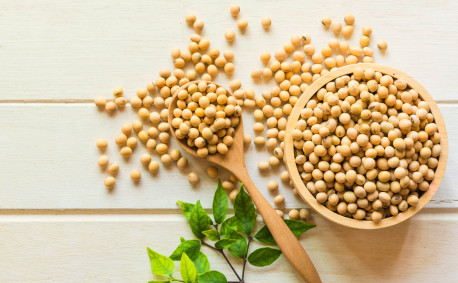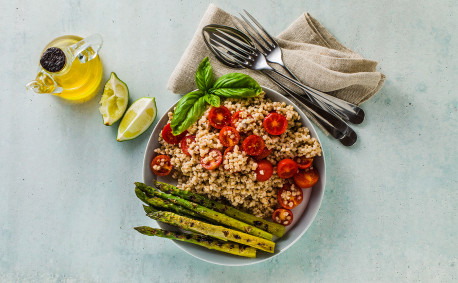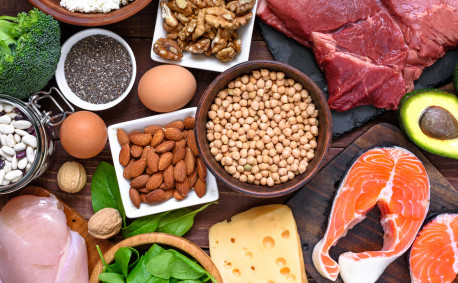Today’s Top Trend Diets
They say too much of a good thing makes it bad. There are a few exceptions — chocolate, good books, lazy Sundays — but largely, the idea holds true. Today, “too much” comes in the form of information.
Sure, it’s nice to be able to Google the weight of a beluga whale or unravel the Great George Clooney Age Mystery (seriously, how does he not age?!), but so much information coming from all directions becomes overwhelming.
The influx of info is especially confusing when it comes to diets. We’re all bombarded with advice about which eating habits to follow, but what do they all mean? What’s gluten? Who is Keto? And most importantly, what foods are best for you?
While we don’t have all the answers, we put together a list of some key points of popular fad diets to help you make the call.
Gluten-Free Diet
Let’s start with the basics here: Simply put, gluten is a protein complex which gives dough its springy, elastic texture. Gluten is found in wheat, rye and barley, so this eating routine cuts those ingredients from consumption.
Gluten is commonly found in products made from flour, meaning most pasta, pizza, bread and dough are out of bounds. However, there are a growing number of gluten-free substitutes available.
Followers of a gluten-free regimen claim removing this protein increases their energy and helps with weight loss.
A common misconception is all grains have gluten, when really, quite a few are fine for people following this diet: Sorghum, quinoa and buckwheat all get the green light.
If you choose to join the sans-gluten team, remember: Gluten typically provides fiber and other nutrients, so make sure to get those necessities from other sources.
If you’re looking for a yummy gluten-free recipe, check out this strawberry shortcake!
Celiac Disease
Many people who follow a gluten-free diet have celiac disease. (That’s right, it’s a disease and not a dietary choice.) Those with celiac disease suffer from damage to the small intestine when they eat gluten — ouch!
Think of it like a severe gluten allergy. People who have it need to be more diligent about avoiding the substance than those who simply remove it for personal reasons.
Celiac sufferers find relief from intestinal pain after cutting out the protein. Many also report seeing improvements such as increased energy and an easier time losing weight once they alter their diet.
Meet a Kansas wheat farmer who has celiac disease!
Vegetarian Diet
Being vegetarian means cutting all meat from the menu (but often allowing for some animal-derived foods, like eggs or dairy. Vegans eliminate all animal foods.). Reasons for choosing this route vary, but common claims are a decreased risk of heart disease, lowered blood pressure and a reluctance to eat other animals.
Some practitioners of this diet also claim it’s beneficial for the environment, saying less meat consumption leads to lower carbon emissions and water usage. However, there’s more to the picture and many people don’t realize ranchers are dedicated stewards of the environment.
Without meat, getting your daily dose of protein can be a challenge, so vegetarians need to take special care in finding protein from other foods. If you’re looking for more protein, a few easy options are milk, eggs, almonds, peanut butter or beans — they’re chock full!
For an easy vegetarian snack, try these granola fruit bars.
Keto Diet
Keto is short for “ketogenic.” The root of this diet is a low-carbohydrate, high-fat regimen which is said to help with weight loss and lower blood pressure. A traditional keto plan consists of 75% healthy fats, 20% proteins and 5% carbs.
Without getting too deep into the science, after your body runs out of fuel (carbs) to keep you energized, it starts to break down fats and proteins, which can help you lose weight — this process is called “ketosis.” Today, keto is gaining popularity among people with type II diabetes, but it was actually created to help treat epilepsy back in the 1920s.
While weight loss is possible, it’s important to note the lack of long-term data about keto. (Keep in mind, carbs aren’t all bad!)
If following this plan, try cheese, avocado, beef, Greek yogurt or seafood, which are all keto-friendly!
Dairy-Free Diet
The dairy-free diet is exactly what you think: removing all dairy products, basically anything made from animal milk. If following this plan, milk, cheese, butter and yogurt are all no-nos.
A common mistake is lumping eggs into this category. While they might be located in the same aisle at the grocery store, eggs are not dairy.
People who eat dairy-free see reduced bloating, clearer skin and improved digestion. However, there isn't strong research to back up the skin claim. Remember, dairy is a strong source of calcium, potassium and vitamin D, so make sure to get those nutrients from other places!
Lactose intolerance — a problem with your body’s ability to digest dairy — is the deciding factor for many. Some dairy products are lactose-free and others have minimal lactose. People with the condition find relief after adjusting their eating habits. If you love dairy, but your stomach doesn't, check out these tips from the National Dairy Council.
Try this sorghum power salad as a delicious, dairy-free entree!
Paleolithic (Paleo) Diet
This craze takes us back to the days of the caveman. Foods which could have been found during the hunter-gatherer times are the only ones on the menu. Items like dairy, legumes and grains — which saw a rise once farming began — are removed, and no processed foods are allowed.
The Paleo Diet is aimed at getting your body back to what the early humans used to eat. Followers believe fast advances in technology, farming and processing foods did not give our bodies enough time to adjust. (Read here for some common farming myths, busted!)
Benefits of Paleo are said to be weight loss, better blood pressure control and improved glucose tolerance.
While following this diet, pack in the fruits, veggies, nuts, lean meats and fish. Since dairy isn’t an option here, make sure to get your calcium from another source!
Intermittent Fasting
The name might speak for itself, but there are two common ways to go about limiting when and how much you eat. The first option is to eat normally for a few days, then only consume a very small number of calories during the next few days. A second route is to limit your eating to a few set hours each day and fast the rest of the time.
While there are no dietary restrictions during the times you can eat, fasters often consume fewer calories than someone on a normal schedule. This decrease in calories can lead to weight loss.
Fasting may also help lower blood pressure and cholesterol levels, but there is not enough long-term research to be sure.
Since the menu is up to you, check out our favorite multigrain muffins for a quick snack or breakfast!
Which Diet is Right for You?
The truth is, only you can answer that! The best advice we can give is to do your research, talk with your healthcare provider or a registered dietitian before making any drastic changes and try not to be overwhelmed by the amount of information out there. (Also, check the quality of your sources.) There’s a lot of research out there on the Mediterranean and DASH diets, which are often considered the gold standards. Happy eating!




